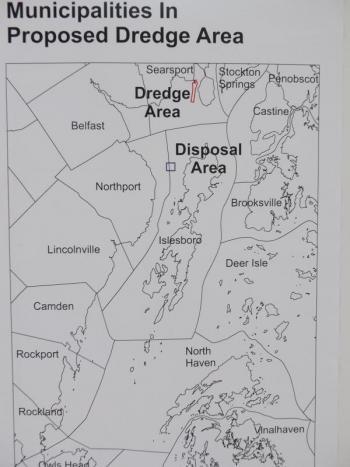Penobscot Bay fishermen applaud Searsport dredging application withdrawal
ROCKLAND — Fishermen of Zone D applauded the Tuesday evening announcement that the Maine Department of Transportation, along with the Army Corps of Engineers, has withdrawn its application requesting a water quality certification for the Searsport harbor dredging project. This application withdrawal effectively puts an end to the proposed dredging project. However, as stated in the brief withdrawal letter, the two departments reserve the right to submit a new proposal in the future.
Department of Marine Resource Commissioner Patrick Keliher made the announcement to the Zone D fishermen at the 8 p.m. finish to a community meeting seeking input for drafting a Governor's bill for the lobstering industry.
The withdrawal letter, addressed to Jim Beyer, Regional Licensing Compliance Manager for the Bureau of Land Quality, Maine Department of Environmental Protection states:
“The U.S. Army Corps of Engineers and the Maine Department of Transportation are withdrawing the Water Quality Certification (WQC)/Natural Resources Protection Act application for the Searsport Harbor, Searsport, Maine Federal Navigation Maintenance and Improvement Project. We may consider submitting a revised application for a Water Quality Certification at a later date. Thank you for your assistance and let us know if any additional information is required.”
Groups and individuals opposing the dredging project included environmentalists, fishermen, and organizations reliant on the fishing and tourism industries. Many of them feared the repercussions of dumping waste dredge in Penobscot Bay, the unsettling of possible mercury, and the clogging of natural methane spouts along the ocean floor.
In early July, Five Maine legislators gathered at the Belfast Boat House to share their reasons for signing a letter that asked the U.S. Army Corps of Engineers and Maine Department of Transportation to produce a comprehensive Environmental Impact Statement before taking further action on dredging Searsport Harbor.
The Army Corps of Engineers and DOT had proposed an $11 million dredging project to deepen the waterway off of the Mack Point facility in Searsport to a depth of 35 to 45 feet in order to allow for commercial ships carrying fuel and chemicals. The dredged material, estimated at a little less than 1 million cubic yards, would then have been disposed at an offshore site between Islesboro and Northport.
The legislators in Belfast July 7 were representing eight more of their colleagues in taking a unified stance. The 13 — Representatives Chuck Kruger, Jeff Evangelos, Mick Devin, Joan Welsh, Walter Kumiega, Adam Goode, Ralph Chapman, Jim Davitt, Pinny Beebe-Center, Christine Burstein Erin Herbig, and Senators Sen. Dave Miramant and Chris Johnson — announced their EIS request in their letter, and said: “We the undersigned duly elected Maine State Legislators request that the Department of Environmental Protection, through the Board or the Commissioner or both, require the Army Corps of Engineers and the Maine Department of Transportation to undertake a comprehensive Environmental Impact Statement before taking further action on the above referenced application.”
In the letter, the legislators stressed that they were not concerned about routine maintenance dredging for Mack Point.
An EIS is a full-disclosure document that details the process through which a transportation project was developed, includes consideration of a range of reasonable alternatives, analyzes the potential impacts resulting from the alternatives, and demonstrates compliance with other applicable environmental laws and executive orders, according to the Federal Highway Administration’s definition. The EIS process in completed in the following ordered steps: Notice of Intent (NOI), draft EIS, final EIS, and record of decision (ROD).
The legislators also wrote in their letter to the Corps and DOT: “There exists controversy and deep concern about the impact the proposal would have on the region’s lobster industry. Both the dredge area and the proposed disposal site, according to University of Maine scientists, are geologically unstable and… The 1 million cubic yards of sediment would smother valuable lobster habitat, rendering that area uninhabitable by numerous marine species, including lobsters, and therefore unproductive, for years… An alternative to the proposed dredging exists that is far less environmentally damaging and could realize most of the proposed project’s purposes.”
In their letter to Chairman James W. Parker of the Maine Board of Environmental Protection, Commissioner Patricia Aho of the Department of Environmental Protection, and Commissioner Patrick Keliher of the Department of Marine Resources, lawmakers noted the concerns residents had with the project.
“Both the dredge area and the proposed disposal site, according to University of Maine scientists, are geologically unstable and thus have the potential to cause sediment plumes, redisposal of sediment... and other unanticipated but deleterious impacts on crustaceans,” according to the letter.
According to Steve Miller, executive director of the Islesboro Islands Trust, lawmakers made a request more than a year ago for the Army Corps of Engineers to answer “crucial questions” regarding the dredging in Searsport. The Corps had not responded to that request.
Those lawmakers, along with the public, sought answers of possible unsettling of heavy metals and possible clogging of ocean floor methane gas holes, which may result in instability of the ground. There was also fear of the availability of lobsters to reduce dramatically, taking with it the livelihoods of fishermen, restaurants, and Midcoast Maine tourism businesses.
Arch Gillies, Chairman of the Islesboro Board of Selectmen, cited his town’s apprehension over the expanded dredging proposal, not the minor maintenance dredging needed to keep Mack Point operational and competitive.
At the July 7 gathering, Rep. Chuck Kruger, D-Thomaston, said: “I think we need to know what we’re doing before we do it. And, I think the taxpayers, who are paying for a huge piece of work to be done to benefit private enterprise, the taxpayers ought to get the best value for their dollar.... We all know that the beautiful, spectacular Penobscot River has also been a sewer for industrial uses for 150 years.”
Sen. Dave Miramant, D-Camden, said: “A few years ago, the sign that said, ’Maine, the way life should be’ came down. And ’Open for business’ went up.”
Miramant cited tax increases for such green industry as solar and wind, and tax decreases for fossil fuels.
Islesboro Selectman Arch Gillies cited the alternative dredging conclusions reached in an independent project review entitled the Dawson Alternative Summary.
Dawson & Associates, of Washington, D.C., had completed an independent review of the U.S. Army Corps of Engineers’ April 2013 Draft Feasibility Report and Environmental Assessment for enlarging the Federal navigation channel serving Searsport to determine whether the proposed channel enlargement was justified.
The Dawson option, which is fully researched, said Gillies, would dredge 80,000 cubic yards instead of the original 1 million cubic yards. The new option would then dispose of the hauled silt in authorized land fills.
Gillies estimated that the U.S. Army’s proposed project would cost $10 to 15 million, whereas the Dawson Alternative would cost $800,000 to $1 million.
Related story:
Midcoast Maine legislators call for full environmental study of proposed Searsport dredge
Reach Sarah Thompson at news@penbaypilot.com.


































